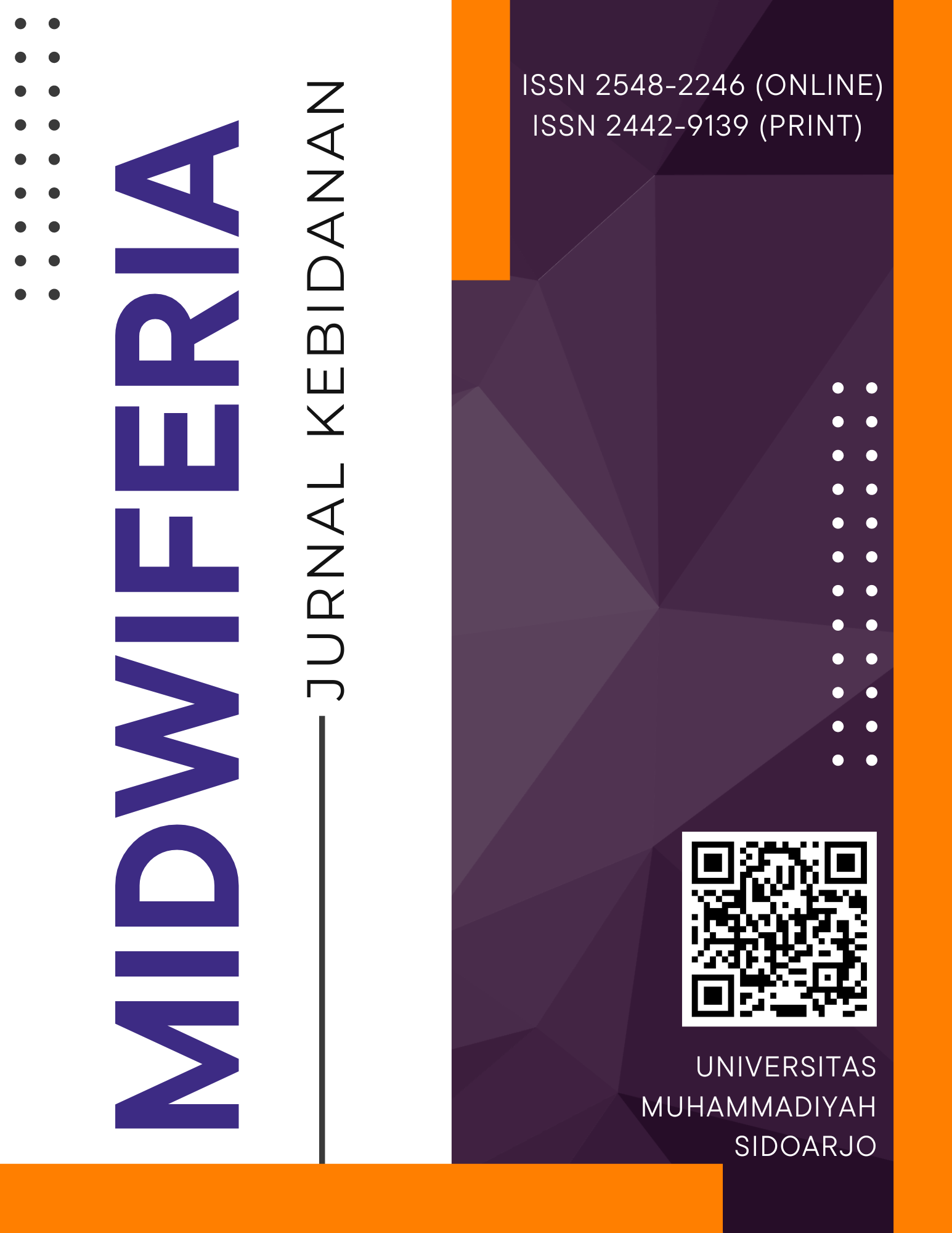Individual, Organizational, and Work Environment Factors Associated with Burnout among Nurses at Sumberglagah Regional Public Hospital
DOI:
https://doi.org/10.21070/midwiferia.v11i2.1742Keywords:
Burnout, Individual Effort, Organization Effort, Work Environment, NurseAbstract
Background: Burnout syndrome among nurses is a critical occupational health issue that can impair job performance, reduce patient safety, and increase turnover rates. This study aimed to analyze the influence of individual factors, organizational factors, and work environment on the incidence of burnout syndrome among nurses at Sumberglagah Regional Public Hospital. Method: A cross-sectional design was employed, involving 99 nurses selected through simple random sampling from a total population of 131 nurses. Data were collected using validated questionnaires measuring individual factors, organizational support, work environment quality, and burnout syndrome using the Maslach Burnout Inventory-Human Services Survey (MBI-HSS). Data analysis included univariate, bivariate (Chi-square), and multivariate (multiple linear regression) tests. Result: The results showed that individual factors (p = 0.000, β = –15.763) and work environment (p = 0.000, β = –10.671) had a significant negative effect on burnout syndrome, indicating that higher scores in these areas were associated with lower burnout levels. Organizational factors (p = 0.107, β = –5.667) were not found to have a statistically significant independent effect. Conclusion: These findings highlight the need for integrated interventions combining personal resilience training with improvements in workplace conditions. Strengthening coping skills, fostering positive thinking, ensuring adequate staffing, and providing supportive physical and psychosocial environments are recommended strategies to reduce burnout risk. Implementing such measures is essential for protecting nurse well-being and maintaining the quality and safety of healthcare services.
References
Afni, Y., & Rahman, A. (2024). Burnout Syndrome pada Perawat di Instalasi Gawat Darurat. Jurnal PPNI Sumbar, 1(1), 39–45.
Al Yahyaei, A., Hewison, A., Efstathiou, N., & Carrick-Sen, D. (2022). Nurses’ intention to stay in the work environment in acute healthcare: a systematic review. Journal of Research in Nursing, 27(4), 374–397. https://doi.org/10.1177/17449871221080731
Alam, R. (2022). Kelelahan Kerja (Burnout). In M. H. Maruapey (Ed.), Penerbit Kampus (1st ed.). Penerbit Kampus.
Belay, A. S., Guangul, M. M., Asmare, W. N., Bogale, S. K., & Manaye, G. A. (2021). Prevalence and Associated Factors of Burnout syndrome among Nurses in Public Hospitals, Southwest Ethiopia. Ethiopian Journal of Health Sciences, 31(3), 543–552. https://doi.org/10.4314/ejhs.v31i3.11
Fardiansyah, A., Syurandhari, D. H., Yuniarti, A. M., Saputra, M. H., & Mafticha, E. (2022). Konsep Dasar Manajamen Kesehatan (R. L. Mahmudah, Ed.; 1st ed.). STIKES Majapahit Mojokerto.
Handayani, R. T., Hasanah, Y. I. F., Zamani, A., Darmayanti, A. tri, Widiyanto, A., & Atmojo, J. T. (2023). Faktor Risiko Terjadinya Sindrom Burnout pada Perawat di Berbagai Jenis Pelayanan. Jurnal Ilmiah Permas: Jurnal Ilmiah STIKES Kendal, 13(3), 1137–1144. https://doi.org/10.32583/pskm.v13i3.1259
Hernawati, S. (2019). Manajemen Rumah Sakit (B. H. Sugito, Ed.; 1st ed.). Forum Ilmiah Kesehatan.
Indiawati, O. C., Sya’diyah, H., Rachmawati, D. S., & Suhardiningsih, A. V. S. (2022). Analisis Faktor Yang Mempengaruhi Kejadian Burnout Syndrome Perawat Di Rs Darmo Surabaya. Jurnal Keperawatan Dan Kesehatan Masyarakat Cendekia Utama, 11(1), 25. https://doi.org/10.31596/jcu.v11i1.1037
Latuconsina, N. A., Salim, N. A., Mubarak, F., Ardyawan, L. O. M. A., Santi, Paulina, Abadi, M. T., Darsono, K., Risnawati, & Handayani, L. (2023). Manajamen Rumah Sakit (Suhadi & Ashaeryanto, Eds.; 1st ed.). PENERBIT CV.EUREKA MEDIA AKSARA.
Sarıköse, S., & Göktepe, N. (2022). Effects of nurses’ individual, professional and work environment characteristics on job performance. Journal of Clinical Nursing, 31(5–6), 633–641. https://doi.org/10.1111/jocn.15921
Serra, J. G., Farias, E. dos S., Nunes, L. de L., Oliveira, M. X. de, & Castro, T. M. de. (2022). Psychology of Health Burnout Syndrome in Nursing Professionals in COVID -19 Intensive Care. Psychology of Health • Paidéia (Ribeirão Preto), 32, 1–9.
Sujanah, W., Pratiwi, A. D., & Akifah, A. (2021). Faktor-Faktor Yang Berhubungan Dengan Burnout Syndrome Pada Perawat Di RSUD Bahteramas, Sulawesi Tenggara. Jurnal Kesehatan Masyarakat (Undip), 9(5), 675–680. https://doi.org/10.14710/jkm.v9i5.30697
Shah, c. o., Gandrakota, N., Cimiotti, J. P., Ghose, N., Moore, M., & Ali, M. K. (2021). Prevalence of and Factors Associated With Nurse Burnout in the US. JAMA Network; Vol. 4; No. 2, 1-11.
Nuraini, S. T., Putri, T. H., & Anggraini, R. (2024). Faktor-Faktor Yang Memengaruhi Kejadian Burnout Pada Perawat: Literature Review. Tanjungpura Journal of Nursing Practice and Education, Volume 6, No. 1, 35-47.
Saputeri, I., Khotimah, H., & Prananto, J. (2023). Hubungan Beban Kerja Dengan Kejadian Burnout Pada Perawat. Jurnal Penelitian Perawat Profesional; Volume 5; Nomor 3, 1175-1182.
Mawaddah, D. W., & Mandagi, A. M. (2024). Literature Review: Factors Related to Burnout Syndrome in Hospital Nurses. Media Gizi Kesmas, 504-511.
Downloads
Published
License
Copyright (c) 2025 Henry Sudiyanto, Irvan Widodo, Arief Fardiansyah

This work is licensed under a Creative Commons Attribution 4.0 International License.






